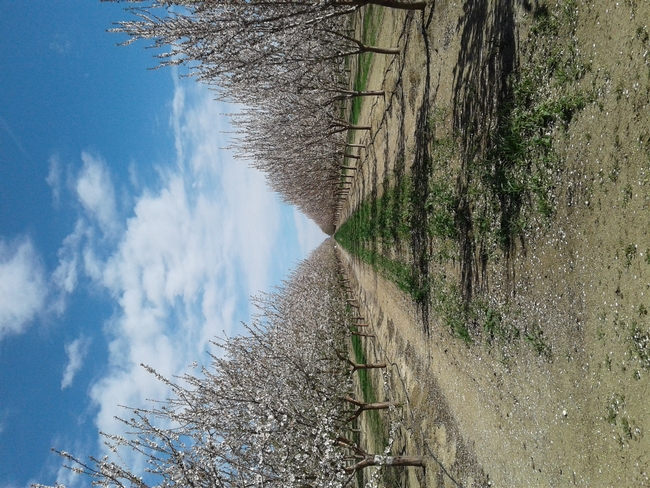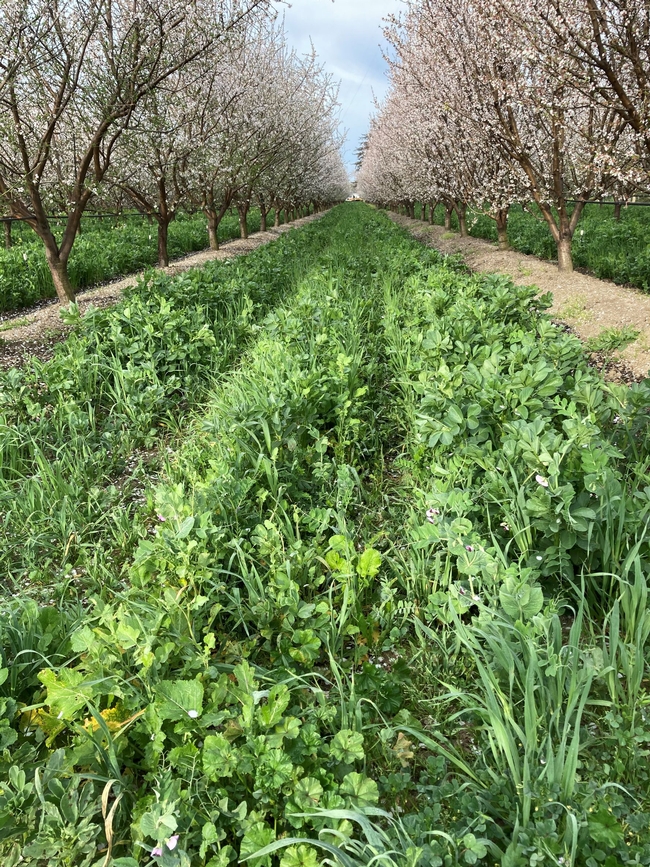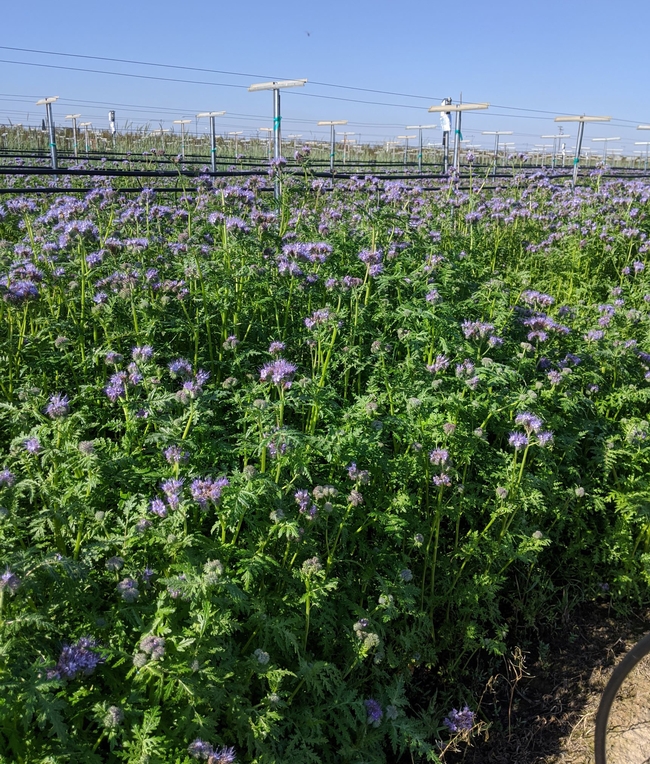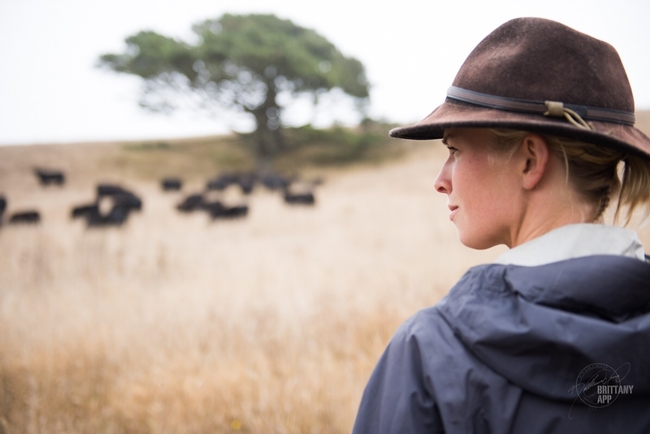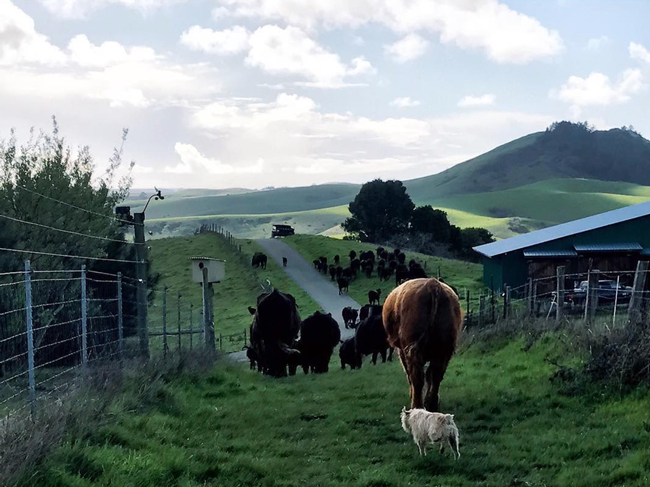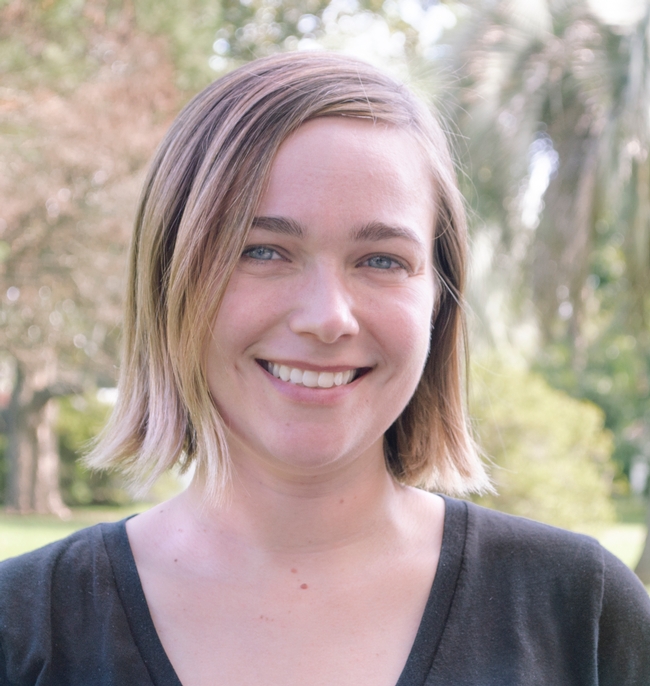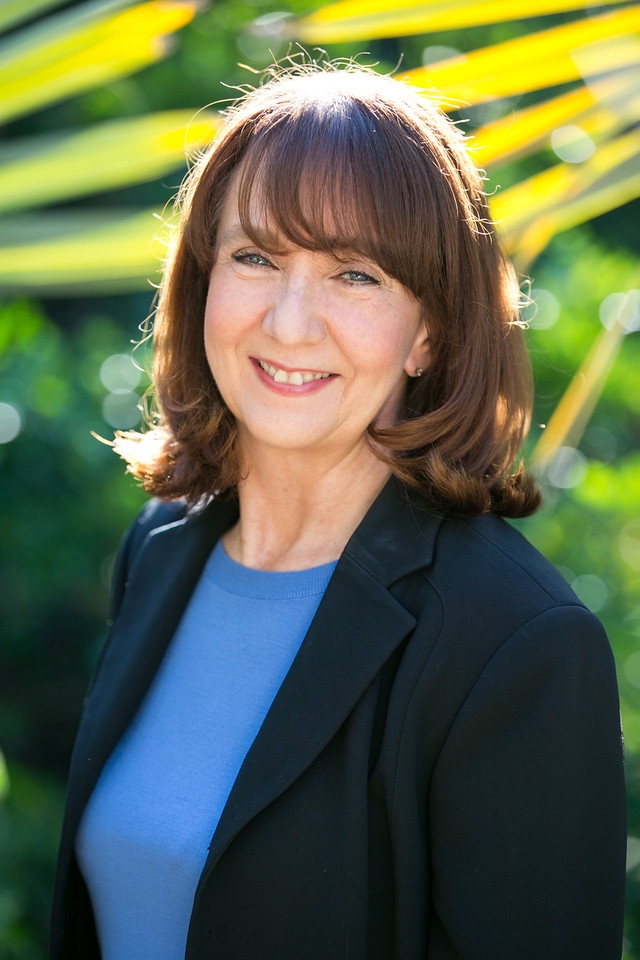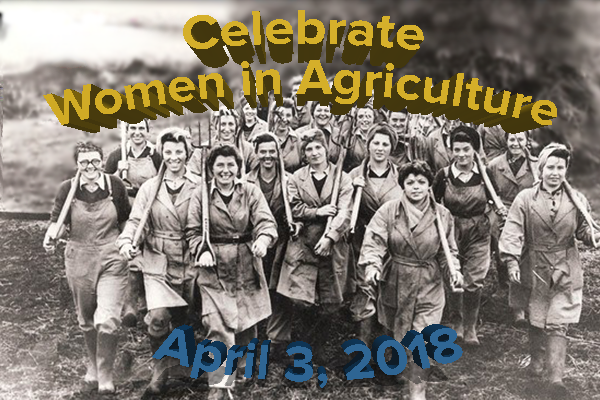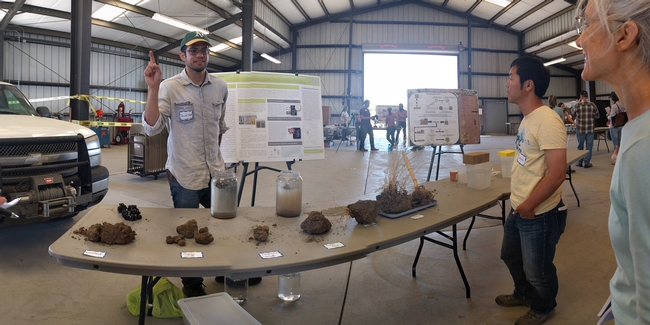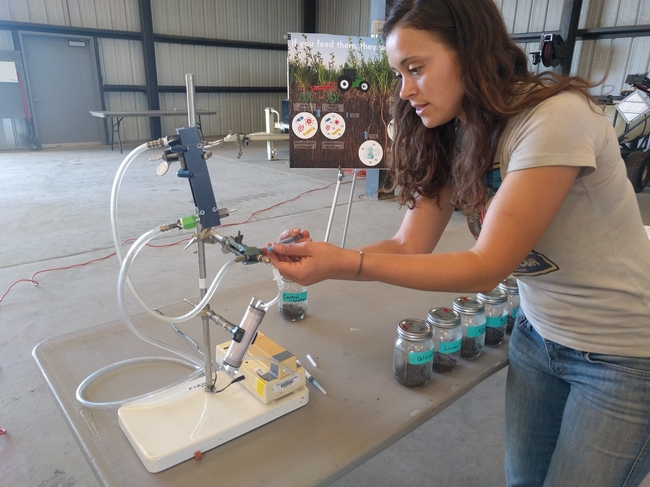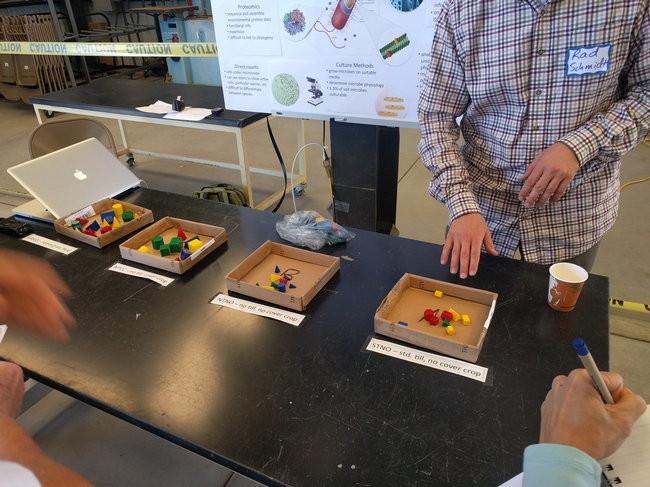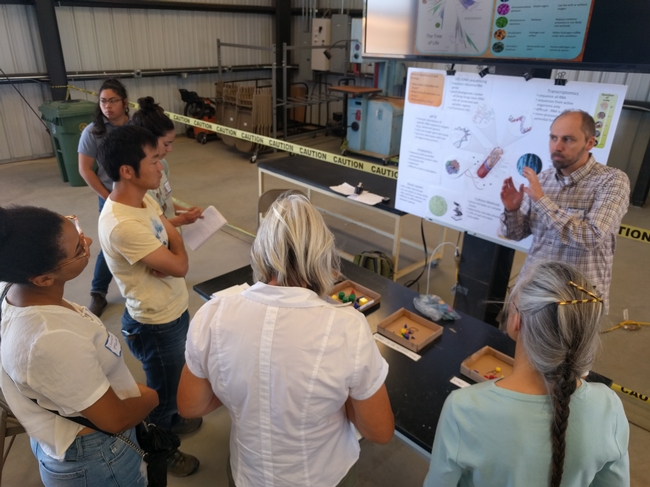Posts Tagged: sustainable agriculture
Can California native plants be used as cover crops to benefit farmers and native ecosystems?
In late February, in an almond orchard in the Sacramento Valley, the fall-planted cover crop mix of grasses, brassicas and legumes had barely produced a green fuzz above the soil surface, and it was unclear when it would bloom. Unfortunately, this scene is becoming more frequent across California, as climate change causes more prolonged droughts and rain-dependent winter cover crops can barely grow, which delays or reduces bloom, essential for supporting pollinators. Fortunately, California native plant species have evolved with drought and have developed many strategies to survive and reproduce in those conditions.
Would it be possible to capitalize on the over 9 million acres of cropland in California for drought resilience and habitat restoration by utilizing more native species as cover crops? Our team at the UC Sustainable Agriculture Research and Education Program (UC SAREP) spent some time considering various native plant species and their potential ecological and operational attributes as cover crops. For a full list of species and their attributes, see https://ucanr.edu/sites/covercrops/.
Many native species are so well adapted to drought that they will still germinate and bloom during extremely dry years, for example, annuals like Tidy Tips (Layia platyglossa) and California poppy (Eschscholzia californica). Alternatively, perennial bulb species like Prettyface (Triteleia ixioides) and Bluedicks (Dipteronstemon capitatus) become dormant during the dry summer, retaining their bulbs below ground and re-growing when the rains return. These species could perhaps fit well in no-till orchard systems. Summer dormancy is important for tree nut growers because they usually need clean ground under the trees during harvest. Moreover, the costs to terminate and reseed would potentially be eliminated. While these species are well-known by Native Americans for their edible bulbs, at this point in time, we are not aware of any cover cropping trials having ever been conducted with these species.
Another species with strong reseeding and more availability is the annual Lacy Phacelia (Phacelia tanacetifolia), which offers an intriguing historical precedent for developing a native species for cover cropping purposes. Native to California, it was introduced into Europe in 1832 by Germans. It is very attractive to pollinators and experienced a boom there in the early 1990s. European beekeepers and farmers have been using Lacy Phacelia as a cover crop ever since, and it has recently been gaining traction on California farms as well. California has many species of phacelia, with another, described as being even more attractive to native bees, being the annual Great Valley Phacelia (Phacelia ciliata). Besides supporting native bees, other native plant species can contribute nitrogen to the soil, such as annual Lupine (Lupinus spp.) and perennial Deerweed (Acmispon glaber), which are legumes and form an association with nitrogen-fixing bacteria in their roots.
Cover crops are not usually considered marketable crops. However, we should not preclude the potential for some plants that are useful as cover crops to provide a harvestable product as well. Native perennial fiber plants such as Indian hemp dogbane (Apocynum cannabinum), narrow leaf milkweed (Asclepsias fascicularis), and common nettle (Urtica dioica) could offer the opportunity to cultivate summer cover crops that have a market value, especially in cases where farmers are already willing to irrigate their cover crops to improve their development and amplify the benefits. Bowles Farming in the San Joaquin Valley is experimenting with growing these three species for fiber production. All three also attract native bees and important butterfly species such as monarchs (as long as farmers avoid spraying insecticides).
While we believe that some native species could open new opportunities for farmers as cover crops, we still have insufficient studies testing the effects and viability of these species. Organizations like the NRCS Plant Materials Center at Lockeford and the Xerces Society are conducting practical studies with native species, creating plant guides and working with farmers to expand their use. In addition, researchers Lauren Hale of the USDA Agricultural Research Service and Anil Shrestha of California State University, Fresno, are using a 2021 UC SAREP small grant to study the effects of native species mixes on water demand and weed populations in San Joaquin Valley grape vineyards. Hale suggests that below-ground ecosystems may benefit as much from native plants as above-ground ecosystems. Says Hale, “Because plants and their microbiomes have evolved together for millennia, it seems logical that native plants would promote a good response from the native soil microbiota.”
For additional information:
UC SAREP List of California Native Species for Potential Use as Cover Crops: https://ucanr.edu/sites/covercrops/
Xerces Society lists of pollinator-friendly native species for California: https://xerces.org/pollinator-resource-center/california
NRCS California Plant Materials Center plant guides: https://www.nrcs.usda.gov/wps/portal/nrcs/publications/plantmaterials/pmc/west/capmc/pub/
UC SAREP Cover Crops Database: https://sarep.ucdavis.edu/covercrop
Why Drones Are Important in Sustainable Agriculture in the 21st Century
Drones... If you're thinking of apiculture, you might be thinking of drones (male bees). But if you're thinking of agriculture--more specifically...
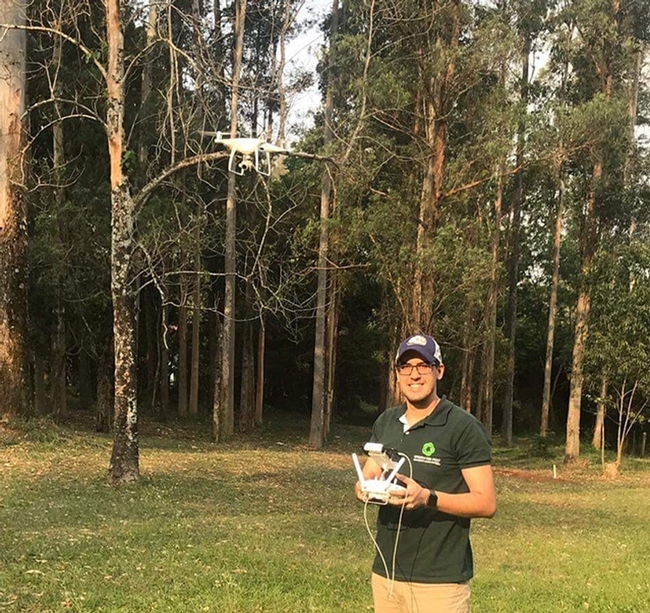
Lead author and entomologist Fernando Iost Filho of the Department of Entomology and Acarology, University of Sao Paulo, Brazil. He is a former UC Davis exchange student.
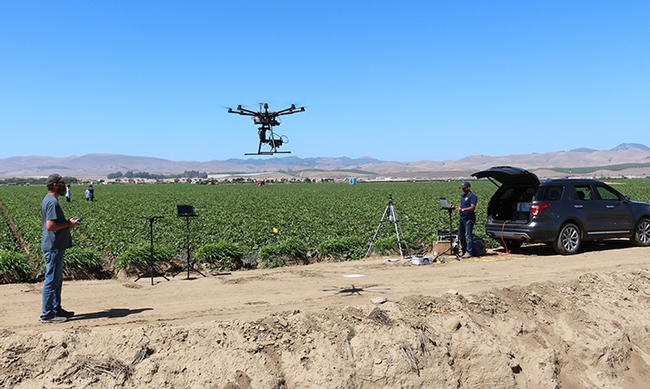
A drone over a Santa Monica strawberry field. Drones can target pest outbreaks or hot spots in field crops and orchards, the scientists pointed out. (Photo by Elvira de Lange)
Change on the range
“When first-generation ranchers succeed, we all succeed,” says Kate Munden-Dixon, a Ph.D. student working with Leslie Roche, Cooperative Extension rangeland specialist with the UC Division of Agriculture and Natural Resources and the UC Davis Department of Plant Sciences.
Munden-Dixon and Roche recently discovered that many new livestock managers aren't plugged into information networks such as UC Cooperative Extension and rancher coalitions that provide science and strategies for making sustainable rangeland management decisions. This lack of connection can make first-generation ranchers more vulnerable when dealing with challenges like drought and climate variability, according to their study, which was recently published in Rangeland Journal.
To help bridge the gap, Munden-Dixon landed a $25,000 Graduate Student Grant from Western Sustainable Agriculture Research and Education, a USDA program, to reach out to new ranchers and rangeland managers.
Why rangelands matter
More than one half of California — 38 million acres — is rangeland that provides open space, healthy watersheds, carbon storage, food, fiber and habitat for diverse plants and wildlife. UC Davis research indicates grasslands and rangeland have become more resilient at sequestering or consuming carbon dioxide pollution than forests in California, making them especially important in a warming world.
But rangeland and livestock production are at risk because more rangeland is being converted to housing and crop production. The average age of ranchers in California is 62, and fewer children are taking over the family ranch.
Enter a new wave of rangeland managers. Many of these young ranchers don't yet have access to the capital required to purchase land and large head of cattle and other livestock. Instead, they often contract with public and private landowners to graze goats, sheep and cattle to restore landscapes and reduce fire vegetation.
“What we really need is support in connecting land and contract opportunities,” says Brittany Cole Bush, an “urban shepherdess” and former contract sheep and goat grazer. She now consults with land owners and public agencies from her home base in Southern California. “We need market research that shows the value that grazing brings to fire abatement, soil conservation and so much more. Market research would increase our value and help us become viable players.”
Expanding Extension
Munden-Dixon is interviewing 40 new rangeland managers from across California to explore how decision-making by different demographics influences adaptation to climate change and quality of life. Munden-Dixon and her team are also hosting workshops to make sure Cooperative Extension specialists understand and can respond to all ranchers' needs.
“There is both a need and opportunity for a new generation of livestock managers that is able to adapt to California's changing climate,” Munden-Dixon says. “This next generation may not look like your typical rancher, so we want to ensure organizations are helping all ranchers succeed, regardless of their demographics or land tenure.”
The power of connection
Munden-Dixon would like to become a Cooperative Extension specialist herself one day. Working with first-generation ranchers reminds her that collaboration and public engagement are critical to addressing issues in sustainable agriculture.
“There is no one answer or single expert when it comes to building healthy food systems,” Munden-Dixon says. “We find solutions when we work together.”
See this story in the Fall/Winter 2018 issue of Outlook, a magazine from the UC Davis College of Agricultural and Environmental Sciences, and at the UC Davis Science & Climate website.
UCCE advisor Rachel Surls receives 2018 Bradford Rominger Agricultural Sustainability Leadership Award
The Agricultural Sustainability Institute at UC Davis has announced that Rachel Surls, UC Cooperative Extension sustainable food systems advisor for Los Angeles County, is this year's recipient of the Eric Bradford and Charlie Rominger Agricultural Sustainability Leadership Award.

The Bradford Rominger award, given yearly, honors individuals who exhibit the leadership, work ethic and integrity epitomized by the late Eric Bradford, a livestock geneticist who gave 50 years of service to UC Davis, and the late Charlie Rominger, a fifth-generation Yolo County farmer and land preservationist.
“In her three decade career with UCCE, Rachel has developed a strong program addressing some of our most critical issues in sustainable agriculture,” says Keith Nathaniel, the Los Angeles County Cooperative Extension director. “She does so with innovative strategies, working with all aspects of the LA community. After 30 years doing this work, she continues to be active in the community she serves.”
In Surls' career, gardening has been a tool to build science literacy for school children, to increase self-sufficiency for communities impacted by economic downturn, and to create small businesses for urban entrepreneurs. As the interest in and support for urban agriculture has grown, she has been in the heart of Los Angeles, ready to respond to the needs of the city's farmers and gardeners.
Her role at Cooperative Extension started as a job to help start school gardens in LA. “I would drive to any school that wanted me and help them dig in the gardens,” Surl said. “I could find teachers who were interested in starting gardens, but I couldn't find principals and administrators to support it.”
Early on, some counseled Surls to find an area of expertise that was more serious than community and school gardens. Despite the criticism, “I just chugged along, doing what I knew was good and what I cared about,” Surl said.
And over time, the value of these programs has become more apparent, and support for them has grown. Surls continued along, working to start community gardens at public housing facilities, and overseeing the Los Angeles County UC Master Gardener program.
In 1997, she stepped into a role as the UC Cooperative Extension county director, ensuring the success of extension efforts for all of Los Angeles County for the next 14 years.
In 2008 came the great recession, and with it an uptick in public interest in home grown food.
“We were getting more and more calls in our office on how to be more self-sufficient,” Surls said. “The economics of the time rattled people, so they were thinking more about how to grow their own food, and how to maybe make some money by selling what they grow. And people needed the support and guidance to do that.”
Surls and her partners are working to meet that need through workshops in California's largest metropolitan areas and a website of resources to help new urban farmers get a leg up on farming in the city. Surls is also a member of the leadership board for the Los Angeles Food Policy Council.
The energy around urban agriculture today is palpable. And a career path that was once not taken seriously now is.
“That has really changed in our institution and culture,” Surl said. “We're hiring people to do this work!”
Persistent and focused, Surls' work is one of the reasons that progress is happening.
Surls will receive the award at the Celebrating Women in Agriculture event in Davis April 3. The event is free and open to the public. Learn more about the event here.
Powers of microbes: UC Davis graduate students get creative to teach farmers about soil microbiology
If you grew up in the 1980s or 1990s (or were a child at heart during that era), the famous Powers of Ten film likely left an indelible mark in your mind.
The film starts with a couple lounging on a picnic blanket and zooms out to the outer reaches of the universe, then back in to peer into the microscopic world of the human body: from white blood cells to DNA, and finally down to the proton of a carbon atom.
In its short 9-minute run time, Powers of Ten manages to inflame an existential angst about the size of a single human life while at the same time connecting the viewer to the beauty of the universe and the human body.
As a high school student watching the video, it filled me with the same sense of awe that I felt the first time I heard Carl Sagan's famous quote that “we are all made of star stuff.”
Powers of Ten reminds us that looking at the world from different perspectives, from the very tiny to the immensely large, helps create a better understanding of the natural world, our place within it, and how we can impact it for good.
Had Powers of Ten returned from outer space by zooming into a piece of soil rather than a the human body, it would have explored the billions of living creatures in one handful of soil, slowly scaling down from millipedes to earthworms to ants to nematodes to protozoa, and finally down to the soil's bacteria and fungi that make up the base of the soil food web.
The video might then have looked a lot like the recent workshop at the Russell Ranch Sustainable Agriculture Facility, which served as a science fair for farmers and researchers to learn about the minuscule but powerful soil microbe.
While farmers often have a baseline knowledge about soil microbiology and its importance on the farm, “the science is evolving so quickly at this point, that it can be hard to keep up,” said attendee Margaret Lloyd, UC Cooperative Extension advisor who works with small-scale farmers in Yolo and Sacramento counties.
The workshop coupled foundational principles of soil microbiology with practical on-farm management situations, making the case for farmers to actively consider soil bacteria, fungi, and other micro organisms in their decision-making process.
Jessica Chiartas, a fourth-year graduate student in soil microbiology and one of the workshop organizers, is somewhat of a soil science evangelist.
Her hope was to help workshop attendees better understand that “soils are not just physical, chemical systems. A majority of the processes that take place underfoot are biologically driven. Soils are living and breathing bodies and much like us, they need to be fed, covered, and protected from disturbance” in order to function in the long term.
Scaling down
The scale of microbial activity in soil makes it challenging to help farmers dig into just what scientists are talking about when they talk about microbes.
“It's important to talk about the scale of microbes,” Chiartas said. “So much of what goes on in soils is mediated by microbes and the scale that they operate on is far different than the scale we measure them at. Our typical method of soil sampling and analysis is analogous to harvesting whole fields of crops, chopping them up, throwing them in a heap and then trying to glean information about the individual plants.”
The presenters at the soil health workshop used vivid analogies to translate the abstract results of scientific research and hard-to-imagine scales into concrete, relatable concepts.
A single gram of soil may contain a billion bacteria, and several miles of fungal hyphae, the web-like growth of fungus. Translated into human scale, the numbers are mind boggling.
If a single microbe were a 6-foot-tall person, then a single millimeter of soil would be as tall as the empire state building. A typical soil bacterium contains as many DNA letters in its chromosome as two copies of “War and Peace.” A stack of copies of “War and Peace” equivalent to bacterial DNA from a single teaspoon of soil would be larger than the Great Pyramid of Giza.
A soil information revolution
The metaphors of scale are a fun thought experiment, and they could provide a jumping-off point for a discussion between farmers and scientists essential for improving our current understanding of soil as a living system. Climate change is expected to amplify the effects of soil erosion, compaction, nutrient leaching and other issues common in our current agricultural systems.
“We need improved management that works with the soil ecosystem to increase crop production while enhancing soil health,” said Radomir Schmidt, a postdoctoral researcher and workshop organizer. ”That's going to take a concerted effort and open dialog between farmers, scientists, and citizen scientists to discover, test, and implement these methods in the real world.”
We are now in the era of “soil information revolution," Schmidt said. As our knowledge of the soil microbiome expands, implementing this knowledge in agricultural practice is more and more possible.
This graduate student cohort is well-positioned to make the necessary connections, learning from farmers while helping them zoom in to see the essential lifeforms that impact their farm, then zoom out to help make decisions that are good for the farmer, good for the crop, and good for the microbe.
Farmers in the Davis area will have another opportunity to learn soil health fundamentals at a workshop this fall hosted by the UC Sustainable Agriculture Research and Education Program and Russell Ranch Sustainable Agriculture Facility. Details about the workshop will be posted here.


